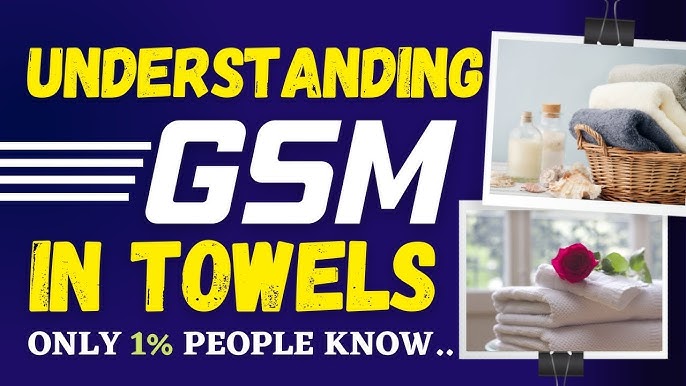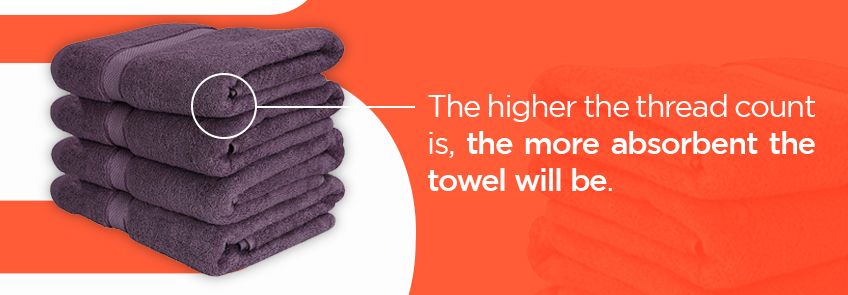The abbreviation GSM is “Grams per Square Meter.” It is a unit of measurement for weight or density that can be applied to a variety of materials, including textiles like paper and fabric. GSM is frequently used to determine the fabric’s thickness and density in the context of towels.
Table of Contents

A greater GSM value on a towel indicates that it is thicker, denser, and usually of higher quality. Higher GSM towels are frequently more robust and absorbent. They have a thicker, more opulent feel to them. Conversely, towels with a lower GSM are thinner and lighter and might be used for various purposes—for example, as kitchen or exercise towels.
The following common rules can be used to understand GSM ratings on towels:
300–400
thinner, lighter towels that are great for the gym, playing sports, or using in the kitchen.
400–600
Hand or guest towels that are medium-weight and appropriate for regular use
600–900
Thick, heavy towels that are usually used as bath towels or bath sheets. They have a plush, extremely absorbent feel.
It’s crucial to pick a towel with the right value for your unique requirements and tastes. Various values are appropriate for various uses, so think about what features you value most in a towel—thickness, absorbency, or speed of drying—and make your selection accordingly.
What is the ideal thread count for a towel?
The utilization of thread counts as a metric for assessing towel quality is not customary, unlike its application in the context of bedding. When considering towels, the metric of thread count, denoting the quantity of horizontal and vertical threads per square inch of fabric, is not as significant as it is for sheets.
In the evaluation of towel quality, the GSM (grams per square meter) is typically prioritized due to its ability to provide insights into the towel’s density, weight, and thickness. These parameters are crucial in determining the towel’s absorbency and overall level of quality.

Regarding the thread count of towels, it is mostly influenced by the towel’s manufacture and can exhibit substantial variation. Towels of superior quality frequently have a greater mass and are crafted from long-staple cotton, typically characterized by elongated and finer fibers. These attributes enhance their capacity for absorption and overall softness.
The determination of an optimal thread count for towels is not well defined. Rather, the quality of the material, the weaving technique employed, additional elements such as GSM, the specific type of cotton utilized (e.g., Egyptian or Pima cotton), and the finishing procedures employed collectively contribute to the overall quality of the towel.
How is the quality of a towel affected by its thread count?
The determination of a towel’s quality is not commonly reliant on its thread count, as is the case with bedsheets. When considering towels, various aspects exert a more substantial influence on their quality. The significance of thread count, denoting the quantity of horizontal and vertical threads per square inch of fabric, is diminished in the assessment of towels.
The following are the primary determinants that influence the overall quality of towels:
GSM
The GSM (grams per square meter) metric is utilized to quantify the weight, density, and thickness of a towel. A greater GSM often indicates a towel with increased thickness and absorbency. The GSM of towels is frequently associated with their quality, although it is not the sole determinant to be taken into account.
Fiber type
The quality of towels is notably influenced by the fiber type employed, with particular emphasis on cotton. Long-staple cotton, such as Egyptian or Pima cotton, is frequently favored due to its exceptional attributes of durability, softness, and absorbency.
Weave type
The texture and absorbency of a towel are influenced by the weaving style employed, such as terry or waffle weave. Terry towels, including loops on both surfaces, have gained popularity due to their high absorbency characteristics.
softness
The softness and overall feel of a towel can be influenced by the finishing processes employed following the weaving stage. Techniques such as combed cotton and ring-spun cotton have the potential to augment the overall quality.
Durability
Towels of high quality are specifically engineered to endure regular usage and laundering without compromising their form, hue, or texture. The inclusion of reinforced hems and double-stitched seams enhances the overall longevity of the product.
Absorbency
The absorbency of towels is a crucial factor as it pertains to their ability to efficiently and promptly remove moisture from the body. The influence on this matter is mostly determined by the specific variety of cotton employed and the particular weaving technique employed in the production of the towel.
Colorfastness
Colorfastness is an essential characteristic of high-quality towels, as it ensures their resistance to fading and color bleeding throughout the washing process. Ensuring the preservation of the towel’s visual integrity is of utmost importance.
Lint and shedding
The presence of an excessive amount of lint and shedding may indicate the utilization of inferior materials or suboptimal manufacturing techniques. Towels of high quality are expected to generate a small amount of lint.
In conclusion, although thread count may hold significance in evaluating the quality of bed linens, it does not hold the same level of importance when considering towels. Several crucial criteria contribute to the assessment of towel quality, including the GSM (grams per square meter), the specific fiber employed, the weaving methodology, durability, absorbency, colorfastness, and resistance to lint. When deciding on towel selection, it is recommended to prioritize these factors over thread count.
What is the best GSM in towels?
This section provides a comprehensive overview of GSM frequency bands and their appropriateness for various applications.

Towels with a low GSM range of 300–400
These are characterized by their lightweight nature and thinner composition. These towels exhibit rapid drying properties and are frequently deemed appropriate for use in gymnasiums, sporting activities, or as kitchen accessories. These towels may exhibit reduced plushness and thickness.
Towels with a medium GSM range of 400–600
exhibit a harmonious equilibrium between their weight and thickness. These towels are appropriate for regular usage and are commonly employed as either hand towels or guest towels. These products provide a favorable equilibrium between their absorbent properties and their ability to dry rapidly.
Towels falling under the high GSM range (600–900+)
are characterized by their increased weight, thickness, and enhanced level of opulence. These materials possess a notable capacity for absorption and offer a luxuriously soft tactile experience. These items are commonly employed as bath towels or bath sheets to enhance the bathing experience, resembling that of a spa.
When evaluating the most suitable GSM (Global System for Mobile Communications) for one’s requirements, it is advisable to take into account the following factors:
Absorbency
Towels with more GSM (grams per square meter) are often more absorbent as a result of their increased density.
Softness
Towels with a higher GSM (grams per square meter) measurement are often perceived as more opulent and velvety in texture.
Drying time
The drying time of towels is influenced by their GSM, with lower GSM towels often exhibiting faster drying rates compared to higher GSM towels.
Dimensions
The dimensions of towels with higher GSM can result in increased spatial requirements, necessitating additional storage capacity.
The optimal GSM for towels is ultimately contingent upon individual preferences and the specific intended application.
want to buy a towel click here